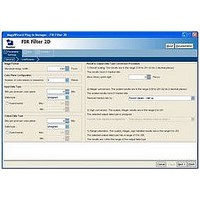IPSR-VIDEO Altera, IPSR-VIDEO Datasheet - Page 72

IPSR-VIDEO
Manufacturer Part Number
IPSR-VIDEO
Description
RENEWAL Of IPS-VIDEO
Manufacturer
Altera
Series
IP Suitesr
Datasheet
1.IPS-VIDEO.pdf
(202 pages)
Specifications of IPSR-VIDEO
Software Application
IP CORE, SUITES
Supported Families
Arria GX, Cyclone II, HardCopy II, Stratix II
Features
Common Avalon Streaming (Avalon-St) Interface And Avalon-St Video Protocol
Core Architecture
FPGA
Core Sub-architecture
Arria, Cyclone, Stratix
Rohs Compliant
NA
Lead Free Status / RoHS Status
na
- Current page: 72 of 202
- Download datasheet (6Mb)
4–14
Video and Image Processing Suite User Guide
There are five signals types (ready, valid, data, startofpacket, and endofpacket)
associated with each port. The din_ready signal is an output from the MegaCore
function and indicates when the input port is ready to receive data. The din_valid
and din_data signals are both inputs. The source connected to the input port sets
din_valid to logic '1' when din_data has useful information that should be sampled.
din_startofpacket is an input signal that is raised to indicate the start of a packet,
with din_endofpacket signaling the end of a packet.
The five output port signals have equivalent but opposite semantics.
The sequence of events shown in
1. Initially, din_ready is logic '0', indicating that the MegaCore function is not ready
2. The MegaCore function sets din_ready to logic '1', indicating that the input port is
3. The source feeding the input port sets din_valid to logic '1' indicating that it is
4. The source feeding the input port holds din_valid at logic '1' and drops
5. No data is transmitted for a cycle even though din_ready was logic '1' during the
6. Data transmission resumes on the input port: din_valid transitions to logic '1' and
7. The third pixel is input and the first processed pixel is output.
8. For the final sample of a frame, the source sets din_endofpacket to logic '1',
to receive data on the next cycle. Many of the Video and Image Processing Suite
MegaCore functions are not ready for a few clock cycles in between rows of image
data or in between video frames. For further details of each MegaCore function,
refer to the
ready to receive data one clock cycle later. The number of clock cycles of delay
which should be applied to a ready signal is referred to as ready latency in the
Avalon Interface
Image Processing Suite uses have a ready latency of one clock cycle.
sending data on the data port and sets din_startofpacket to logic '1' indicating
that the data is the first value of a new packet. The data is 0, indicating that the
packet is video data.
din_startofpacket indicating that it is now sending the body of the packet. It puts
all three color values of the top left pixel of the frame on to din_data.
previous clock cycle and therefore the input port is still asserting that it is ready for
data. This could be because the source has no data to transfer. For example, if the
source is a FIFO, it could have become empty.
the second pixel is transferred on din_data. Simultaneously, the MegaCore
function begins transferring data on the output port. The example MegaCore
function has an internal latency of three clock cycles so the first output is
transferred three cycles after being received. This output is the type identifier for a
video packet being passed along the datapath. For guidelines about the latencies
of each Video and Image Processing MegaCore function, refer to
page
din_valid to '1', and puts the bottom-right pixel of the frame on to din_data.
5–75.
“Functional Descriptions” on page
Specifications. All of the Avalon-ST interfaces that the Video and
Figure 4–12
is:
5–1.
January 2011 Altera Corporation
Avalon-ST Video Protocol
“Latency” on
Chapter 4: Interfaces
Related parts for IPSR-VIDEO
Image
Part Number
Description
Manufacturer
Datasheet
Request
R

Part Number:
Description:
CYCLONE II STARTER KIT EP2C20N
Manufacturer:
Altera
Datasheet:

Part Number:
Description:
CPLD, EP610 Family, ECMOS Process, 300 Gates, 16 Macro Cells, 16 Reg., 16 User I/Os, 5V Supply, 35 Speed Grade, 24DIP
Manufacturer:
Altera Corporation
Datasheet:

Part Number:
Description:
CPLD, EP610 Family, ECMOS Process, 300 Gates, 16 Macro Cells, 16 Reg., 16 User I/Os, 5V Supply, 15 Speed Grade, 24DIP
Manufacturer:
Altera Corporation
Datasheet:

Part Number:
Description:
Manufacturer:
Altera Corporation
Datasheet:

Part Number:
Description:
CPLD, EP610 Family, ECMOS Process, 300 Gates, 16 Macro Cells, 16 Reg., 16 User I/Os, 5V Supply, 30 Speed Grade, 24DIP
Manufacturer:
Altera Corporation
Datasheet:

Part Number:
Description:
High-performance, low-power erasable programmable logic devices with 8 macrocells, 10ns
Manufacturer:
Altera Corporation
Datasheet:

Part Number:
Description:
High-performance, low-power erasable programmable logic devices with 8 macrocells, 7ns
Manufacturer:
Altera Corporation
Datasheet:

Part Number:
Description:
Classic EPLD
Manufacturer:
Altera Corporation
Datasheet:

Part Number:
Description:
High-performance, low-power erasable programmable logic devices with 8 macrocells, 10ns
Manufacturer:
Altera Corporation
Datasheet:

Part Number:
Description:
Manufacturer:
Altera Corporation
Datasheet:

Part Number:
Description:
Manufacturer:
Altera Corporation
Datasheet:











